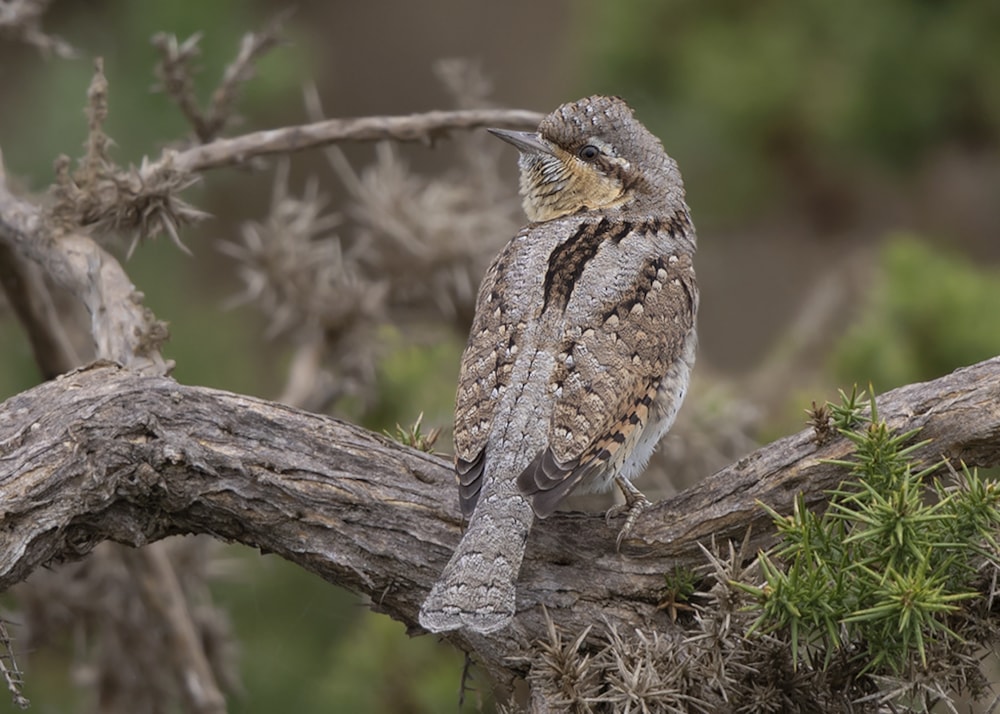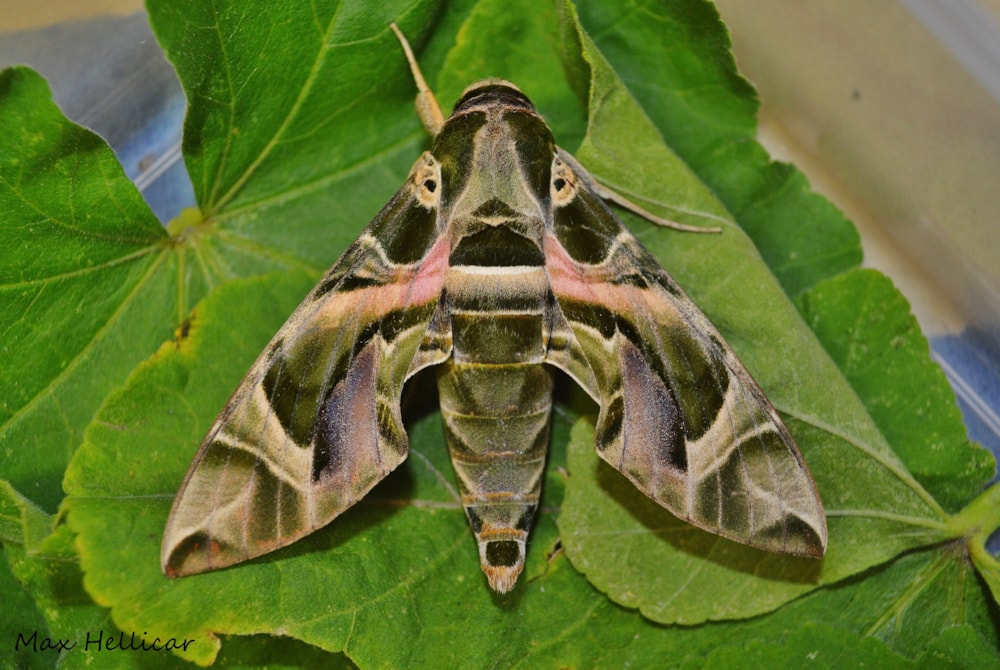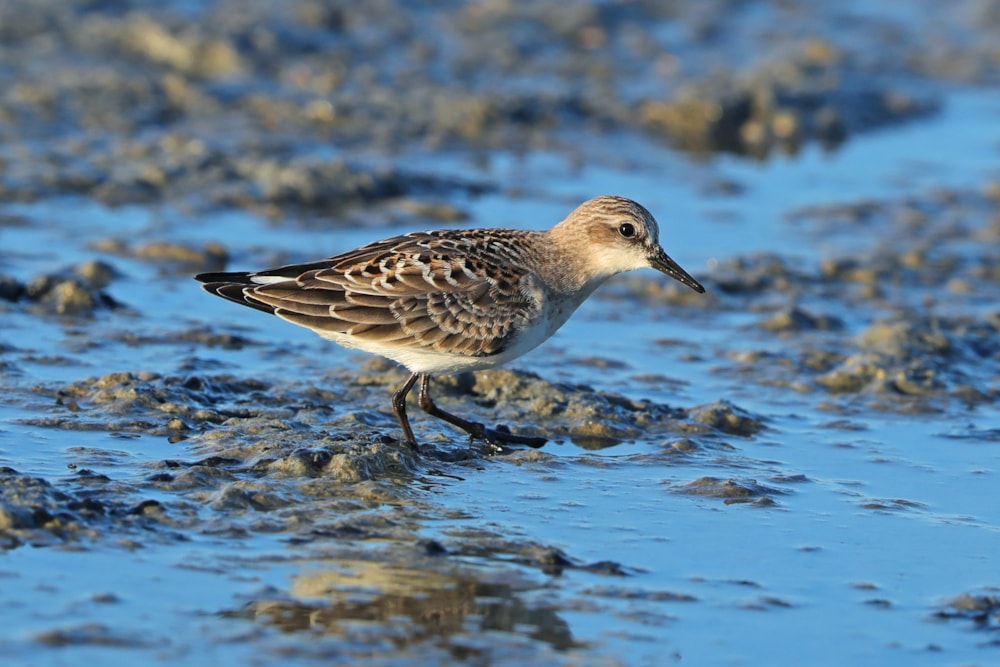It certainly felt like another mediocre stage to be working on for the first half of the week, with no easterlies to speak of resulting in another challenging few days on the east coast. Even Shetland and Orkney made do with a rationing of scarcities, many of which were lingering birds from last week. Towards the end of the week, remnants of Storm Helene brought blustery conditions to western coasts and reignited the seabirding scene. As a forerunner to this, an intriguing report emerged from Cornwall of a Bulwer's Petrel rafting with Manx Shearwaters off Porthgwarra on 13th before heading west. Seawatching efforts from the Hebrides hot-spot of Rubha Ardvule produced another legendary seabird on 16th in the form of a southbound Barolo Shearwater, which will be just the fifth Scottish record if accepted. The next day, mind-blowing scenes from Co Cork saw no fewer than five Fea's-type Petrels towering over the waves off Galley Head in the space of just 75 minutes – though of course the possibility remains that some of these may have been the same bird looping round. Expectations were high for Ireland and Cornwall on 18th but the reality was something of an anti-climax, though another Fea's-type did belt past Toe Head, Co Cork.
After the seven-year gap before the Dungeness American Black Tern, the next wasn't such a long time coming: a juvenile on the Bann Estuary, Co Derry, was identified as surinamensis on 12th, its third day on site, and based itself there to the end of the week. Meanwhile, the drake American White-winged Scoter seemed at home on the Firth of Forth off Musselburgh Lagoons, Lothian, throughout, offering a wonderful opportunity to appreciate the taxon at relatively close range as it drifted in towards the sea wall. After going to ground for 10 days, the White-throated Sparrow on Foula, Shetland, revealed itself again on 18th and seemed in fine fettle.
To the delight of many, the juvenile Semipalmated Sandpiper materialised once more on the Wyre Estuary at Ramper Pot, Lancs, on 15th and made itself readily viewable there for the remainder of the week, sometimes within photographic range. Up to nine Baird's Sandpipers were on offer this week, including a popular and confiding pair of juveniles on Gann Estuary, Pembs, from 13-16th. The Isles of Scilly had a lingering juvenile on Tresco to 17th, as well as one on Bryher from 14-17th and possibly a separate bird on St Agnes on 16th. Others were unearthed in Findhorn Bay, Moray, on 17th and at Baltasound, Unst, Shetland, on 14th. Ireland boasted juveniles at both Bannow Bay, Co Wexford, and Trawmore Beach, Co Mayo, on 15th.

Semipalmated Sandpiper, Skippool Creek, Lancashire (Sam Northwood).

Baird's Sandpiper, Gann Estuary, Pembrokeshire (Brian Southern / Pembrokeshire Birds).
A juvenile Lesser Yellowlegs was fresh in at Devoran Quay, Cornwall, on 18th, when a White-rumped Sandpiper was on South Uist, Outer Hebrides. In Lincolnshire, Frampton Marsh RSPB's adult Long-billed Dowitcher loitered to 16th. New American Golden Plovers were found at Marshside RSPB, Lancs, on 12th and Omey Strand, Co Galway, on 13th, with a fly-over at Seven Heads, Co Cork, on 16th. The Tiree, Argyll, bird also found company in a fresh arrival on 12th, with one of these staying on the island to 17th. Other loitering individuals were at Deerness, Orkney, and Tacumshin, Co Wexford to 16th.
Buff-breasted Sandpipers were littered sparingly, totalling 19 between the Isles of Scilly and Shetland but with the majority naturally turning up on western coasts. A southbound bird past Spurn, East Yorks, on 17th stood out. A total of 32 Pectoral Sandpipers was distributed even-handedly, with three of these arriving at Tacumshin, Co Wexford, on 13th and two frequenting the Abbey Pool on Tresco, Scilly, on 15th. There's certainly a lot of room for improvement on the American wader front; while a few vagrants are reaching us, their overall paucity in spite of the fast-track weather systems over the Atlantic is getting slightly concerning. Still, there's plenty of time yet.

American Golden Plover, Sandaig, Tiree, Argyll (John Bowler).

Buff-breasted Sandpiper, St. Mary's, Isles of Scilly (Kris Webb).
An evening visit to Vange Marsh RSPB, Essex, scored a Marsh Sandpiper on 13th, though it was gone by morning. It's tempting to speculate that this is the same, shy bird which was around the inner Thames Estuary in July and August. The week's only migrant Eurasian Dotterel were represented by fly-throughs at Pennington Marshes, Hants, on 12th and Pegwell Bay, Kent, on 13th, as well as an approachable juvenile at Cross Lough, Co Mayo, on 16th. Burton Mere Wetlands RSPB, Cheshire, produced a report of a brief Red-necked Phalarope on 16th.

Eurasian Dotterel, Cross Lough, Mullet, Mayo (Josh Jones).
Popular Grey Phalaropes were at Cheddar Reservoir from 14-16th and at Huntspill from 17-18th, both Somerset, while very small numbers featured in western seawatches, along with a few Sabine's Gulls, Long-tailed Skuas and Leach's Storm Petrels. Great Shearwaters featured strongly, while Cory's Shearwaters quietly fizzled out, with western seawatching sites churning out several three-figure counts, including 305 past Lizard Point, Cornwall, on 16th.
The current glut of Pallid Harriers was sustained by new juveniles at Colaton Raleigh Common, Devon, from 13-14th and at Bank End, Lancs, from 16-18th. Another juvenile, found at Welney WWT, Norfolk, on 13th was considered a Montagu's Harrier for the first four days of its stay and was still around on 18th, not far from an additional bird which had pitched up in the area of the Ouse Washes just over the border into Cambridgeshire the previous day. Therfield, Herts, was probably always the most likely spot for a Pallid to turn up in the county and a juvenile there on 18th was a welcome adrenaline boost for locals. The Fair Isle bird remained only to 12th but the juvenile male lurked around Burton Marsh and Little Neston, Cheshire, to 17th.

Pallid Harrier, Welney WWT, Norfolk (Paul Ward).
Gibraltar Point NNR, Lincs, held onto its juvenile Red-footed Falcon to 14th and others were chanced upon over Benington, Herts, on 15th and Nosterfield LNR, North Yorks, on 16th. Migrating European Honey Buzzards were clocked over Higham, Kent, on 14th then Beachy Head, East Sussex, and Seasalter, also Kent, on 17th. On the Outer Hebrides, 'Snedge', the female Snowy Owl, was still watching over St. Kilda to at least 15th.

Red-footed Falcon, Gibraltar Point NNR, Lincolnshire (Ian Bollen).
On 15th, newly arrived Spotted Crakes appeared at Oare Marshes KWT, Kent, and Old Moor RSPB, South Yorks, the latter still showing on 18th. Long stayers still around towards the end of the week were at Pennington Marshes, Hants; Burton Mere Wetlands RSPB, Cheshire; Willen Lake, Bucks, and Wilstone Reservoir, Herts. One of the birds at Otter Estuary NR, Devon, was still present at the beginning of the review period and could well still be there but a path closure now prevents access to the viewpoint. Migrant Corncrakes were on North Ronaldsay, Orkney, on 13th and on Bardsey Island, Gwynnedd, on 16th, when a road casualty was also discovered at Ancroft, Northumberland.
A juvenile Purple Heron was reported at Chew Valley Lake, Somerset, on 13th. A Glossy Ibis graced Marazion RSPB, Cornwall, from 13-14th and another toured Swillington Ings, West Yorks, on 15th. In Devon, the Fremington Pill bird was still in place on 18th and the next day singles flew over Hightown, Lancs, and Nanjizal Valley, Cornwall. Another tracked west over Cley, Norfolk, on 18th.
The adult Forster's Tern in Co Louth was stationed at Navvy Bank, Dundalk, on 13th and the adult Bonaparte's Gull resurfaced at Long Rock, Co Sligo, on 15th. Three Ring-billed Gulls, all adults, were shared between Black Rock Strand, Co Kerry, on 12th and the cities of Galway and Sligo on 14th and 16th respectively.
A first-winter Citrine Wagtail showed up at Porth Hellick Pool on St. Mary's, Scilly, from 14th and saw the week out but the only other report was of a fleeting visitor to Loch of Strathbeg RSPB, Aberdeens, on 15th. Wrynecks, although still widely scattered mainly in the south, dropped to 17 birds, mainly in the south and included a duo still at Landguard NR, Suffolk, on 13th.

Wryneck, Dungeness NNR, Kent (Steve Ashton).
The Hoopoe at Cromarty, Highland, was still to be easily found on the short turf near the lighthouse to 18th and another visited a private garden on Hayling Island, Hants, on 12th. A Red-rumped Swallow zipped south over the North Denes in Lowestoft, Suffolk, on 16th. Devon had two juvenile Rosy Starlings: at Skern, Northam Burrows, on 12th and in Wembury on 15th. The long-staying adult was on St Kilda, Outer Hebrides, to 15th at least and another was found at Lansdown, Somerset, on 14th.

Hoopoe, Cromarty, Highland (harry bell).
A Bonelli's warbler sp flitting around North Haven on Skomer, Pembs, on 16th was not a shy bird, and allowed itself to be photographed well, but didn't utter an all-important call to identify it to species level. Shetland scored Blyth's Reed Warblers on Foula from 16-18th and Fair Isle, where one was ringed on 18th. An Arctic Warbler made a brief and rather quaint appearance in a tea room garden in Lowestoft, Suffolk, on 13th and others were at Cunningsburgh, Shetland, on 13th and on Fair Isle from 14-18th. In Orkney, North Ronaldsay's Greenish Warbler just made it into the week by staying to 12th. Icterine Warblers were almost non-existent, the only bird reported being an individual trapped and ringed at Gibraltar Point NNR, Lincs, on 13th which made its way back into the nets three days later. A Melodious Warbler was on Mizen Head, Co Cork, on 12th, while the long-stayer at Caerthillian Cove, Cornwall, was available to 15th, after which it seemed to move off.

Melodious Warbler, Kynance Cove, Cornwall (Martin Webb).
Most of the week's 18 Barred Warblers were on Shetland and Orkney, with many of these seemingly just handed over from last week. One on Harris on 16th was noteworthy for the Outer Hebrides, as was an individual on Ramsey Island, Pembs, on 14th. Others included one lingering at Winterton Dunes NNR, Norfolk, to 13th and another at nearby Happisburgh from 15-16th, as well as a ringing record at Melvich, Highland, on 13th. Yellow-browed Warblers seem to be far from swamping the news pages, with the total of 17 birds exclusive to Shetland and Orkney, but this could all change in a flash within the next week or so, given half-favourable winds.

Yellow-browed Warbler, Skaw, Unst, Shetland (Micky Maher).
A first-winter Woodchat Shrike was a one-day affair at Brauton Burrows, Devon, on 12th and another spent 16-18th at Barns Ness, Lothian. Red-backed Shrikes remained thin on the ground with one of the Pembrokeshire first-winters hanging on at Dale Airfield to 15th, while the bird at Whitburn, Co Durham, stayed to 13th. Others were along the Bolt Trail, Devon, on 12th and on The Lizard, Cornwall, from 14-15th. The first Little Bunting of the autumn was at Lund, Unst, Shetland, on 17th, when the season's first Bluethroats also arrived, on Out Skerries, Shetland, and at Farlington Marshes HWT, Hants.

Woodchat Shrike, Barns Ness, Lothian (Frank Golding).
The week's Ortolan Buntings were of course crammed into southern Britain but for once none were mere shapes on a sonogram. Several arrived on 13th, when lone birds overflew Seaford Head, East Sussex, and Pegwell Bay, Kent. That day birds were grounded at Worth Marsh, Kent; Bishop's Dyke, Hants, and Northwick Warth, Glos, but these paused long enough only for a few lucky locals to connect. Thankfully, a bird pinned down at Portsdown Hill, also Hants, on 14th allowed a leisurely twitch over two days. The continued arrival on 14th also involved three at Hastings CP, East Sussex; two at Durlston CP, Dorset, and singletons at Dungeness, Kent, and over North Baddesley, Hants.

Ortolan Bunting, Portsdown Hill, Hampshire (Lee Fuller).
Shetland accounted for the vast majority of the week's Common Rosefinches, with at least 23 scattered around the islands, including a nice flock of six on Out Skerries on 18th. Away from there was a showy singleton hanging on at Spurn from last week to 14th and a one-dayer at Duncansby Head, Highland, on 15th. West coast birds pitched up at Calf Sound, Isle of Man, from 16-18th and Skokholm, Pembs, on 16-17th, as well as on Lewis, Outer Hebrides, on 18th. One was on St Mary's, Scilly, on 18th, and a juvenile on Cape Clear, Co Cork, on 18th is well worth a mention. The Northern Isles and Outer Hebrides were received modest numbers of Lapland Buntings, where the island of Vatersay boasted the week's highest count of six on 13th.

Common Rosefinch, Skokholm, Pembrokeshire (Skokholm Warden).
Living up to the standard set by seemingly all Tawny Pipits so far this year, a bird at Beachy Head early on 17th vanished too soon for anybody to travel to appreciate it. It's still just a tad on the early side for Richard's Pipit, and without favourable winds, two birds was an understandable return. One which turned up at Oxey Marsh, Hants, on 14th completed a short weekend scarcity circuit on the Saturday, nicely complementing nearby Spotted Crake and Ortolan Bunting. Fair Isle had the other on 14th.
Scotland's drake King Eider, currently in eclipse plumage, was tracked down off Nairn Golf Course on 17th and 18th, while the drake Ferruginous Duck was still at Loch Leven, Perth and Kinross, to 13th. A drake Ring-necked Duck was in the southwest corner of Gartmorn Dam, Forth, on 16-17th. An eclipse drake American Wigeon toured Rutland Water from 17-18th, conceivably being the return of the bird last seen in April.
Finally, of note, an Oleander Hawkmoth was on show at Dungeness, Kent, on 17-18th.

Oleander Hawkmoth, Dungeness NNR, Kent (Max Hellicar).
Western Palearctic
If accepted, a juvenile Red-necked Stint at Hyères, Var, from 17-18th will be the sixth record for France and the first youngster to be identified there.

Red-necked Stint, Hyères, Var (Aurélien Audevard).
A South Polar Skua was logged some 250 nautical miles NNE of Lanzarote on 16th and another was photographed 50 nautical miles off Safi on 16th, potentially representing Morocco's second record. In Bern, Switzerland's sixth Terek Sandpiper was at Hagneck Delta for its second day on 11th. The Mtsvane Kontshki Beach in Georgia held an Egyptian Nightjar on 17th. Another tantalising near-continent report of a Black-winged Kite came from Nationaal Park De Groote Peele, Limburg, Netherlands, on 17th. Malta's fourth Blyth's Reed Warbler was at Ghadira Nature Reserve on 15th.

Blyth's Reed Warbler, Ghadira Nature Reserve, Malta (Nicholas Galea).
A Black-throated Diver at Vestmannsvatn on 15th was a major rarity for Iceland, where there is surprisingly only one previous record, and had actually been there since late August (it is also presumed to be the bird seen in north Iceland in June).

Black-throated Diver, Vestmannsvatn, Norðurland eystra (Yann Kolbeinsson).

